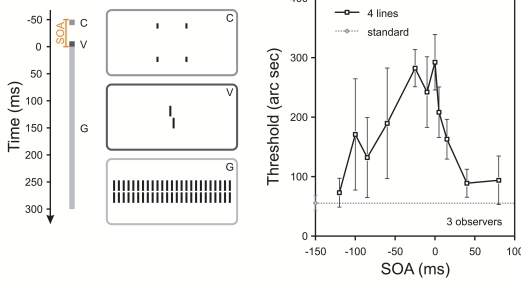Figure 1.
A left or a right offset vernier (V) was presented for 10ms and followed immediately by a grating comprising 25 aligned verniers (G) lasting for 300 ms. Observers had to indicate the offset direction of the vernier in a binary task. The horizontal line in the results graph indicates the threshold in this condition (“standard”). In addition to the standard grating, four contextual lines could be displayed with varying SOAs in relation to the vernier onset (SOA denotes the onset asynchrony of contextual lines (C) relative to the standard grating). These lines appeared above or below the third grating element to the left and right of the center. Lines were separated by a small vertical gap of 200’’ from the grating and presented for 5 ms or 10 ms (a SOA of -50ms is shown in the stimulus sketch). Performance strongly deteriorated for SOAs from -100 ms to 30 ms, i.e. much longer than the duration of the four lines. Reprinted from Vision Research, 43, Herzog M.H., Schmonsees U., & Fahle M., Timing of contextual modulation in the shine-through effect, 2039-2051 (2003a), with permission from Elsevier, where further experimental details can be found.

